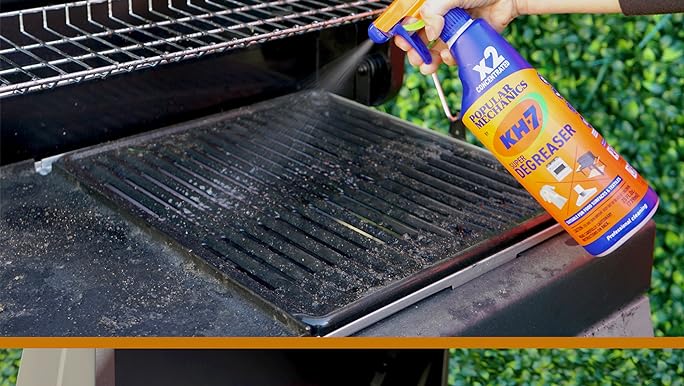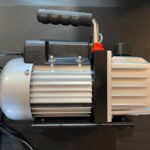What is a Super Heavy Duty Degreaser?
A super heavy duty degreaser is a powerful cleaning solution designed to remove the toughest grease, oil, and grime buildup from surfaces. These degreasers are formulated with highly effective solvents and surfactants that can break down and lift away stubborn, dried-on deposits that regular cleaners cannot handle.
The primary purpose of a super heavy duty degreaser is to effectively clean and degrease industrial equipment, machinery, engines, tools, and other surfaces exposed to extreme grease and oil accumulation. They are commonly used in automotive repair shops, manufacturing facilities, kitchens, and other commercial or industrial settings where heavy-duty degreasing is required.
Typical ingredients found in super heavy duty degreasers include:
- Solvents: Powerful solvents like d-limonene, glycol ethers, or petroleum distillates help dissolve and emulsify grease and oil.
- Surfactants: Anionic or non-ionic surfactants help reduce surface tension, allowing the degreaser to penetrate and lift away grime.
- Alkaline agents: Substances like sodium hydroxide or potassium hydroxide create an alkaline solution that can saponify (convert to soap) and remove stubborn fats and oils.
- Corrosion inhibitors: These ingredients help protect metal surfaces from potential corrosion caused by the strong degreasing agents.
Super heavy duty degreasers are formulated to be highly concentrated and effective, making them ideal for tackling the toughest degreasing jobs in industrial and commercial settings.
Table of Contents
When to Use a Super Heavy Duty Degreaser
Super heavy duty degreasers are formulated to tackle the toughest grease, oil, and dirt buildup in industrial and automotive settings. These powerful cleaning solutions are ideal for applications where regular degreasers simply won’t cut it.
In industrial environments, super heavy duty degreasers are essential for cleaning machinery, equipment, and surfaces that accumulate thick layers of grease, grime, and other stubborn contaminants. From automotive repair shops to manufacturing facilities, these degreasers can effectively remove even the most tenacious buildup, ensuring efficient operation and prolonging the lifespan of valuable assets.
Automotive enthusiasts and professionals alike rely on super heavy duty degreasers for tackling the toughest cleaning challenges. Whether it’s degreasing engine components, removing road grime from undercarriages, or restoring shine to wheels and tires, these degreasers can handle it all. Their exceptional cleaning power ensures that even the most caked-on grease and grime are no match for their formulations.
Beyond industrial and automotive applications, super heavy duty degreasers can also be invaluable for homeowners and DIYers tackling particularly stubborn cleaning tasks. From degreasing outdoor grills and ovens to removing years of built-up grime from garage floors and tools, these degreasers can make light work of even the most daunting cleaning projects.
How Super Heavy Duty Degreasers Work
Super heavy duty degreasers are designed to tackle the toughest grease, oil, and grime buildup. They work through a combination of powerful solvents, surfactants, and emulsifying agents that break down and lift away stubborn soils.
The mechanism of action typically involves the following steps:
- Solvents: These are the heavy-hitters that penetrate and dissolve dried, caked-on grease and oil. Common solvents used in heavy duty degreasers include d-limonene (derived from citrus fruits), glycol ethers, and petroleum distillates.
- Surfactants: These are compounds that lower the surface tension between the grease/oil and the surface, making it easier to remove. Surfactants surround and lift the dissolved grease, preventing it from re-depositing.
- Emulsifying Agents: These help suspend and disperse the dissolved grease and oil in the degreaser solution, forming an emulsion that can be rinsed away. Common emulsifiers include ethoxylated alcohols and amine oxides.
The potent blend of solvents, surfactants, and emulsifiers works together to break down the molecular bonds holding the grease and oil to surfaces. This process effectively lifts and removes even the most stubborn, built-up soils, leaving surfaces clean and free of residue.
Many super heavy duty degreasers also contain alkaline builders like sodium hydroxide or potassium hydroxide, which further enhance their grease-cutting power through saponification – the process of converting fats and oils into water-soluble soaps.
Types of Super Heavy Duty Degreasers
Super heavy duty degreasers come in several different formulations, each with its own set of pros and cons. Here are some of the most common types:
Water-Based Degreasers
Water-based degreasers are among the most environmentally friendly options. They are typically made from a combination of surfactants, solvents, and alkaline builders. These degreasers are effective at cutting through grease, oil, and grime, but may not be as potent as solvent-based alternatives.
Pros:
- Relatively safe for the environment
- Non-flammable and low in VOCs
- Generally safe for use around people and animals
Cons:
- May not be as effective on heavy, caked-on grease and oil
- Can leave residue if not rinsed thoroughly
Solvent-Based Degreasers
Solvent-based degreasers are incredibly powerful and can tackle even the toughest grease and oil buildup. They typically contain a blend of petroleum-based solvents, such as xylene, toluene, or methyl ethyl ketone.
Pros:
- Extremely effective at dissolving and removing stubborn grease and oil
- Fast-acting and efficient
Cons:
- Highly flammable and emit harmful VOCs
- Can be toxic if inhaled or ingested
- May damage certain surfaces or materials
Citrus-Based Degreasers
Citrus-based degreasers are a natural and environmentally friendly option. They are made from citrus peel extracts, such as d-limonene, which is an excellent solvent for cutting through grease and oil.
Pros:
- Derived from natural, renewable sources
- Pleasant citrus aroma
- Biodegradable and low in VOCs
Cons:
- May not be as effective on heavy-duty grease and oil
- Can be more expensive than other options
Alkaline Degreasers
Alkaline degreasers are highly caustic and designed for industrial-strength degreasing tasks. They typically contain a combination of sodium hydroxide, potassium hydroxide, or other strong alkalis.
Pros:
- Extremely powerful at breaking down and removing tough grease and oil
- Effective on a wide range of surfaces
Cons:
- Highly corrosive and can damage skin, eyes, and certain materials
- Require careful handling and safety precautions
- Can be harmful to the environment if not disposed of properly
When choosing a super heavy duty degreaser, it’s essential to consider the specific application, the level of grease and oil buildup, and any environmental or safety concerns. Always follow the manufacturer’s instructions and take appropriate safety measures when using these powerful cleaning products.
Top Super Heavy Duty Degreaser Brands
When it comes to tackling tough grease, grime, and oil stains, certain brands stand out for their superior performance in the super heavy duty degreaser category. Here are some of the top commercial and industrial brands known for their effective and powerful formulations:
Zep is a trusted name in the industry, offering a range of heavy duty degreasers like their Purple Degreaser and Formula 5089. These products are designed to quickly cut through the toughest buildup, making them ideal for use in automotive shops, factories, and industrial settings.
Simple Green is a popular choice for its eco-friendly and biodegradable formulas. Their Extreme Aircraft and Precision Degreaser is a heavy hitter, capable of removing stubborn grease, oil, and carbon deposits from various surfaces, including engines and machinery.
Gojo is a leader in the hand cleaner and degreaser market, with products like their Gojo Cherry Gel Pumice Hand Cleaner and Degreaser. These formulations are tough on grease but gentle on hands, making them suitable for both industrial and household use.
Krud Kutter is renowned for its versatile and powerful degreasers, such as the Krud Kutter Original Concentrated Formula and Krud Kutter Tough Task Remover. These products are effective on a wide range of surfaces, from concrete to machinery, and are popular in both commercial and residential settings.
CRC is a trusted brand in the automotive and industrial sectors, offering heavy duty degreasers like their CRC Heavy Duty Degreaser and CRC QD Contact Cleaner. These products are designed to quickly penetrate and dissolve stubborn grease, oil, and grime, making them ideal for use in garages, workshops, and factories.
While these brands are known for their exceptional performance, it’s essential to consider factors such as the specific application, surface type, and environmental regulations when selecting the most appropriate super heavy duty degreaser for your needs.
Using Super Heavy Duty Degreasers Safely
Super heavy duty degreasers are powerful chemical products that require proper safety precautions during use. These degreasers often contain harsh solvents, alkalis, or acids that can be hazardous if mishandled. Here are some essential safety tips for using super heavy duty degreasers:
Personal Protective Equipment (PPE):
- Wear chemical-resistant gloves, such as nitrile or butyl rubber, to protect your hands from exposure.
- Use safety goggles or a face shield to prevent splashes from entering your eyes.
- Wear long sleeves, long pants, and closed-toe shoes to cover your skin and avoid contact with the degreaser.
- Consider wearing a respirator or working in a well-ventilated area to avoid inhaling fumes.
Ventilation:
- Always use super heavy duty degreasers in a well-ventilated area, preferably outdoors or in a space with adequate air circulation.
- If working indoors, ensure proper ventilation by opening windows and doors or using exhaust fans to remove fumes.
Safe Handling:
- Read and follow all instructions and safety precautions on the product label carefully.
- Never mix different degreasers or chemicals, as this can create dangerous reactions.
- Avoid skin and eye contact by taking proper precautions during application and cleanup.
- Store degreasers in their original containers, away from heat sources and out of reach of children and pets.
First Aid for Exposure:
- If the degreaser comes into contact with your eyes, immediately flush them with clean water for at least 15 minutes and seek medical attention.
- In case of skin contact, remove contaminated clothing and rinse the affected area with plenty of water.
- If ingested, do not induce vomiting and seek immediate medical help.
- If inhaled, move to fresh air and seek medical attention if you experience respiratory distress.
Remember, super heavy duty degreasers are powerful chemicals that require caution and responsible handling. Always prioritize safety by following the manufacturer’s instructions, using proper PPE, ensuring adequate ventilation, and being prepared for potential exposure incidents.
Environmental Impacts of Super Heavy Duty Degreasers
Many traditional super heavy duty degreasers contain harsh chemicals that can have negative impacts on the environment. One major concern is their biodegradability, or lack thereof. Non-biodegradable degreasers can persist in the environment for a long time, potentially contaminating soil and water sources.
Water pollution is another significant issue with certain degreasers. When these products are rinsed off surfaces, the chemical-laden wastewater can end up in storm drains, rivers, lakes, and oceans, harming aquatic life and ecosystems. Some degreaser ingredients, such as solvents and surfactants, can be toxic to fish and other marine organisms, even in small concentrations.
Air emissions are also a concern with some super heavy duty degreasers, particularly those containing volatile organic compounds (VOCs). These compounds can contribute to air pollution and smog formation, posing risks to human health and the environment.
To address these environmental concerns, many manufacturers have developed eco-friendly alternatives to traditional degreasers. These products are formulated with biodegradable, non-toxic, and plant-based ingredients, minimizing their environmental impact. Some examples include degreasers made from citrus extracts, plant-derived surfactants, and enzymes. While these eco-friendly options may be slightly less potent than their chemical-based counterparts, they offer a safer and more sustainable solution for degreasing tasks.
DIY Super Heavy Duty Degreaser Recipes
For those looking for a more natural and cost-effective alternative to commercial degreasers, DIY super heavy duty degreaser recipes can be an excellent option. These homemade formulas often rely on common household ingredients that are readily available and environmentally friendly.
One popular DIY degreaser recipe combines baking soda, vinegar, and dish soap. To make it, mix 1 cup of baking soda with 1/4 cup of vinegar and a few drops of dish soap. The baking soda acts as a gentle abrasive, while the vinegar helps to cut through grease and grime. The dish soap adds some extra degreasing power. This mixture can be applied to greasy surfaces, allowed to sit for a few minutes, and then scrubbed and rinsed away.
Another effective DIY degreaser recipe involves mixing equal parts of white vinegar and water in a spray bottle. This simple solution can be sprayed onto greasy surfaces, allowed to sit for a few minutes, and then wiped away. The acetic acid in the vinegar helps to break down and dissolve grease and grime.
For tougher jobs, a DIY degreaser recipe using washing soda (sodium carbonate) can be highly effective. Mix 1/2 cup of washing soda with 1 gallon of hot water and stir until dissolved. This solution can be used to soak greasy parts or applied directly to greasy surfaces with a scrub brush.
While homemade degreasers may not be quite as powerful as their commercial counterparts, they can be surprisingly effective, especially for light to moderate grease and grime. Additionally, they are often more environmentally friendly and significantly less expensive than store-bought options.
Tips for Effective Degreasing
Proper surface preparation is crucial for effective degreasing. Start by removing any loose debris, dirt, or grime from the surface using a scraper or brush. This will allow the degreaser to penetrate and work on the stubborn grease and oil stains more effectively.
Dwell time, or the amount of time the degreaser is left on the surface before rinsing, is an important factor. Most heavy-duty degreasers require a few minutes of dwell time to break down the grease and oil. Follow the manufacturer’s instructions for the recommended dwell time, as leaving the degreaser on too long can damage certain surfaces.
Agitation is another key element in effective degreasing. After allowing the degreaser to dwell, use a stiff-bristled brush or scrub pad to agitate the surface. This helps to loosen and lift the grease and oil, making it easier to rinse away.
Thorough rinsing is essential after degreasing. Use a high-pressure water stream or a hose with a strong spray nozzle to completely remove the degreaser and dissolved grease from the surface. Failure to properly rinse can leave residue behind, which can attract more dirt and grime.
For particularly stubborn grease and oil stains, try these tricks:
- Apply the degreaser and cover the area with a plastic sheet or wrap. This will trap the fumes and allow the degreaser to work more effectively.
- Use a heat gun or hot water to warm the surface before applying the degreaser. Heat can help break down the grease and oil, making it easier for the degreaser to penetrate.
- For vertical surfaces, apply the degreaser from the bottom up to prevent streaking and ensure even coverage.
- For textured or porous surfaces, use a degreaser gel or thickened formula, as it will cling better and penetrate deeper into crevices.
Remember, patience and persistence are key when dealing with heavy grease and oil buildup. Repeat the degreasing process as necessary until the surface is clean and free of residue.
Super Heavy Duty Degreaser FAQs
What is the difference between a heavy duty degreaser and a regular degreaser?
Super heavy duty degreasers are formulated with more powerful solvents and surfactants to tackle the toughest grease, oil, and grime buildup. Regular degreasers are suitable for light to moderate soils, while heavy duty versions are necessary for stubborn, baked-on messes.
Are super heavy duty degreasers safe for all surfaces?
No, you must exercise caution when using these potent cleaners. Many heavy duty degreasers can damage or discolor certain surfaces like aluminum, painted surfaces, or plastics. Always spot test first and refer to the product label for compatibility guidance.
How do I safely dispose of used super heavy duty degreaser solutions?
Proper disposal is crucial, as these products can be hazardous to the environment. Never pour used degreaser down storm drains or directly into bodies of water. Check with your local waste management authorities for the appropriate way to dispose of spent degreaser solutions in your area.
Can I use a super heavy duty degreaser in my home?
While possible, these industrial-strength cleaners are rarely necessary for typical household cleaning. The fumes can be overpowering indoors without proper ventilation. For most home uses, a standard degreaser or multi-purpose cleaner will suffice.
What safety gear should I wear when using a super heavy duty degreaser?
At minimum, chemical-resistant gloves, eye protection, and adequate ventilation are recommended. Some products may require additional PPE like respirators or protective clothing depending on the formulation. Always review the safety data sheet.



